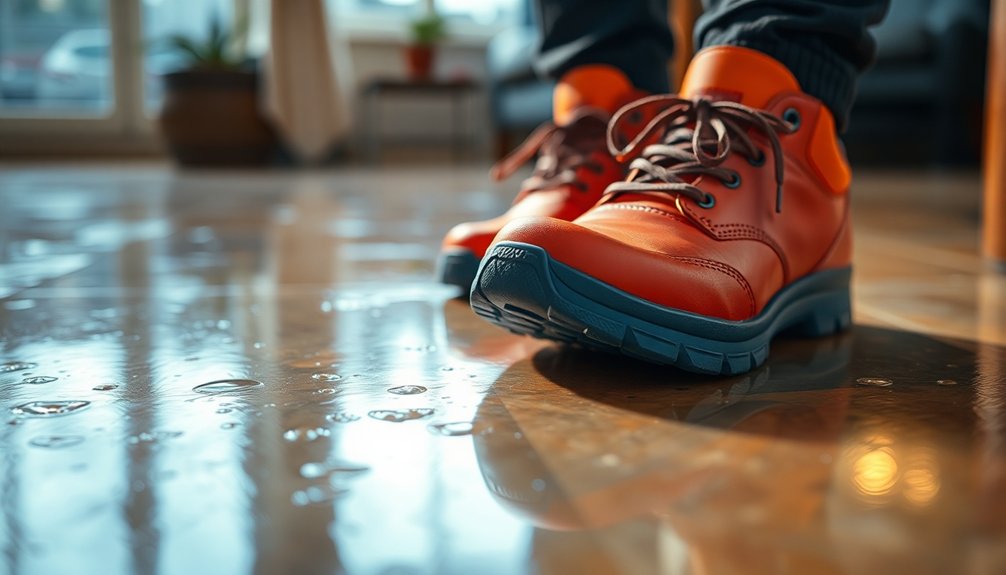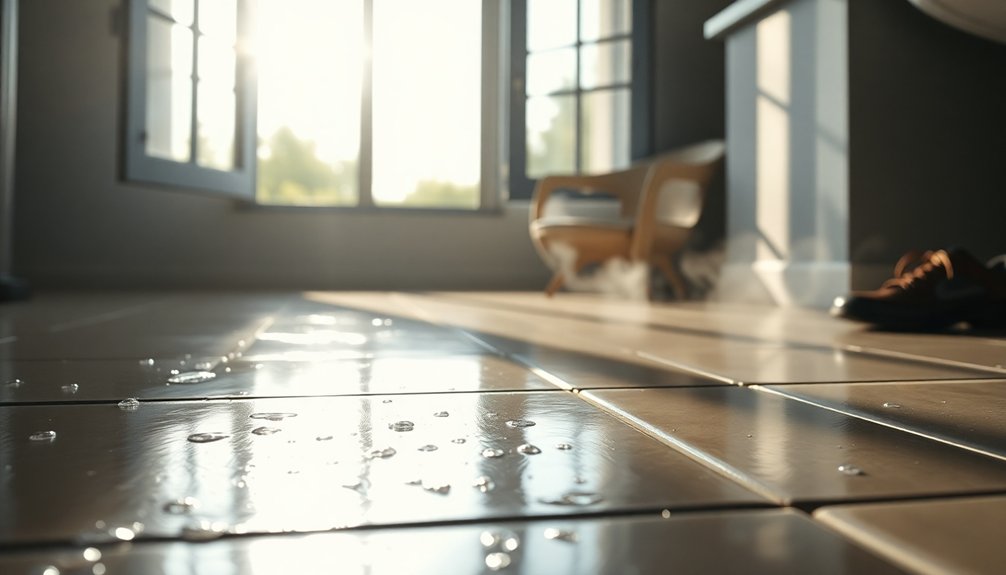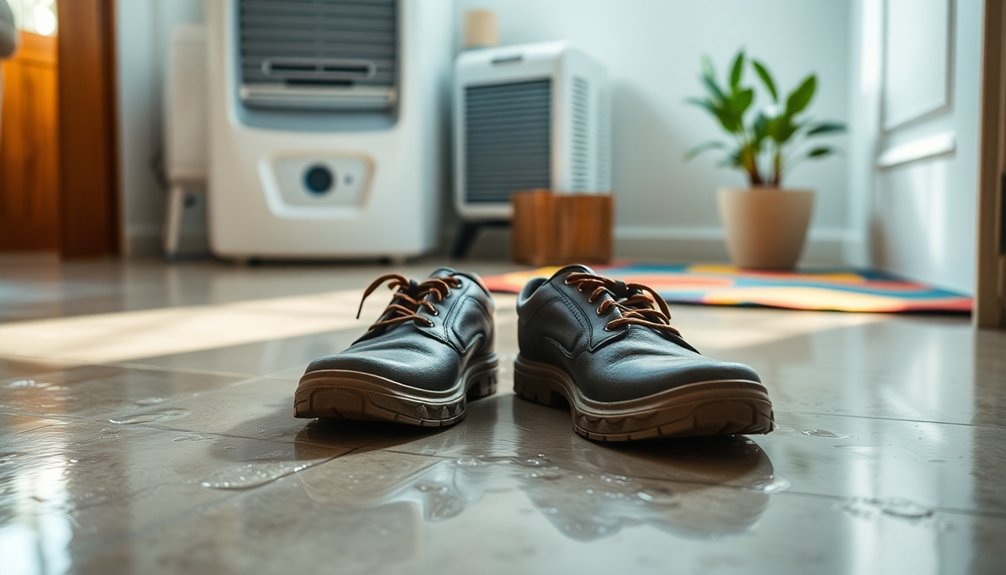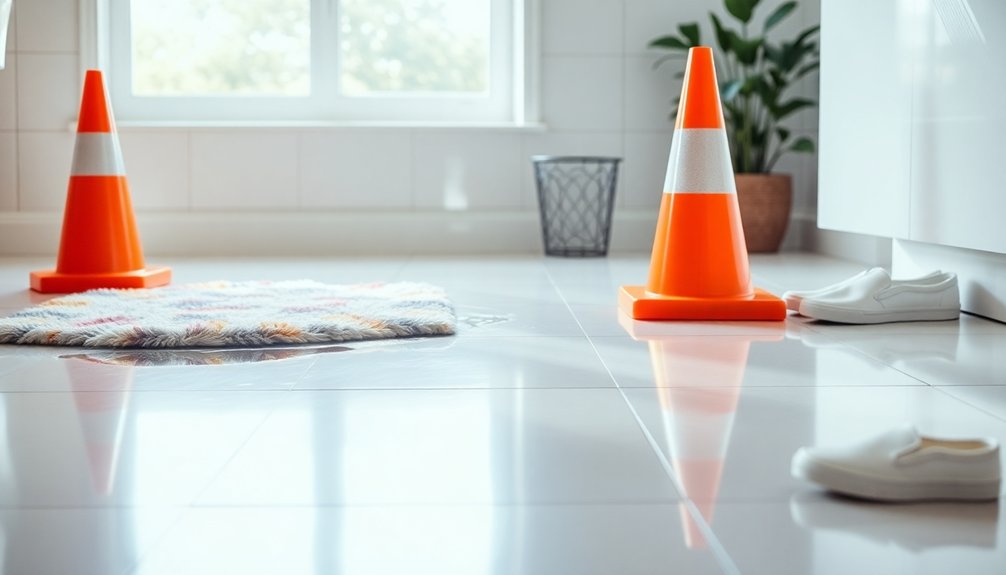Walking on damp floors is risky and can lead to slips and falls, which account for 70% of incidents. To stay safe, check for moisture signs, keep humidity between 30-50%, and guarantee proper ventilation. Choose footwear with rubber soles for better grip and avoid smooth-soled shoes. Act quickly to dry any spills and use fans or dehumidifiers to enhance air circulation. There’s more you can do to create a safer environment and manage moisture effectively.
Understanding the Risks of Walking on Damp Floors
When you walk on damp floors, you greatly increase your risk of slipping and falling due to the reduced traction that wet surfaces create.
Slip and fall accidents account for about 70% of such incidents, highlighting the need for awareness. Excess moisture not only leads to immediate hazards but also contributes to long-term issues like water damage and mold growth, which pose health risks and structural damage.
Slip and fall accidents, making up 70% of incidents, underscore the dangers of excess moisture and its long-term effects.
The type of footwear you wear greatly affects slip and fall safety; smooth-soled shoes can worsen the risk, while rubber-soled shoes provide better grip.
Additionally, tracking water throughout your home can create further moisture-related issues, increasing the likelihood of slips in other areas.
Understanding these risks is essential for maintaining a safe environment. Using apps with receipt scanning technology can help you keep track of expenses related to water damage and other home maintenance costs.
Essential Safety Precautions
To guarantee your safety on damp floors, it’s essential to adopt a series of important precautions that can greatly reduce the risk of slips and falls.
Always check for visible signs of excess moisture, such as puddles or damp areas, before stepping onto a surface. Allow adequate drying time after cleaning or spills; maintaining a humidity level between 30-50% can greatly speed up evaporation.
Confirm proper ventilation in the area to enhance air circulation, which helps dry floors more quickly and lowers slip risks. Additionally, using anti-slip footwear or shoe covers is critical, especially in high-traffic zones. Furthermore, consider implementing payment alerts and reminders to keep track of necessary maintenance tasks like floor cleaning, ensuring safety measures are consistently followed.
Finally, place warning signs around damp areas to alert others and prevent accidents. Taking these steps guarantees a safer environment for everyone.
Choosing the Right Footwear

Selecting the right footwear is essential for traversing damp floors safely. The appropriate shoes not only enhance your comfort but also greatly reduce the risk of slips.
Choosing the right footwear is crucial for safely navigating damp floors and minimizing slip hazards.
Here are key features to look for:
- Slip-resistant soles for better grip on damp surfaces.
- Water-resistant materials to keep your feet dry and comfortable.
- Avoid high-heeled shoes or sandals with smooth soles, as they increase slipping risks.
- Rubber soles provide superior traction compared to leather or plastic.
- Confirm that your footwear fits well, offering adequate support to prevent loss of balance. Additionally, using expense tracking tools can aid in budgeting for quality footwear that ensures safety.
Creating a Safe Environment
To create a safe environment on damp floors, you need to assess the stability of your flooring and implement effective slip prevention strategies.
Proper ventilation plays an essential role in minimizing moisture levels, so consider using fans or dehumidifiers. Additionally, utilizing automated bill payment notifications can help ensure that necessary maintenance and repairs are scheduled on time, contributing to a safer living space.
Assessing Floor Stability
Evaluating the stability of damp floors is essential for guaranteeing safety in any environment.
To assess floor stability effectively, consider these key points:
- Check for visible signs of warping or buckling, indicating potential moisture issues.
- Inspect for mold growth, which can signify hidden moisture problems.
- Verify there’s no standing water on the surface, as even small amounts can lead to slips.
- Use moisture meters to measure the moisture content; if levels are too high, avoid walking on the floor.
- Maintain proper ventilation to promote drying and prevent moisture buildup.
Slip Prevention Strategies
Creating a safe environment on damp floors involves implementing effective slip prevention strategies that protect individuals from potential hazards.
First, make sure proper signage is displayed in areas with moisture risks to alert individuals to potential slip hazards.
Using anti-slip mats or strips in high-traffic zones provides essential traction, reducing the risk of slipping on wet surfaces.
Maintain good lighting to enhance visibility, making it easier for individuals to navigate safely without slipping.
Regularly inspect and maintain flooring to address any moisture issues promptly, preventing pooling.
Finally, encourage the use of appropriate footwear with slip-resistant soles to minimize the risk of slipping on damp floors.
Proper Ventilation Importance
While many may overlook the significance of proper ventilation, it’s essential for maintaining a safe environment, especially in areas prone to dampness.
Proper ventilation helps reduce humidity levels and promotes air circulation, which prevents moisture buildup on floors.
Here are some vital tips:
- Use dehumidifiers to maintain humidity between 30-50%.
- Open windows and utilize exhaust fans for better airflow.
- Regularly monitor and adjust indoor climate conditions.
- Inspect airbricks and vents to prevent blockages.
- Maintain a consistent temperature to avoid condensation.
Effective Floor Drying Techniques
To effectively dry damp floors, start by swiftly removing any standing water with dry towels or a wet/dry vacuum. This will help eliminate surface water and prevent further moisture absorption, especially in concrete floors where moisture in concrete can lead to damage.
Next, increase air circulation by using fans and dehumidifiers to expedite the drying process and enhance moisture control. Gently applying heat with a space heater can also help, but make certain it’s positioned safely to avoid hazards.
If water has seeped underneath the flooring, remove trim and flooring to allow for thorough drying and to prevent moisture-related issues. Remember to keep billing terms clear and concise to avoid misunderstandings about maintenance costs.
Regularly check the moisture levels of the subfloor to make sure everything is completely dry and healthy.
Importance of Ventilation

Ventilation plays an essential role in preventing mold growth and enhancing air quality in your home. By reducing moisture levels through proper air circulation, you can greatly mitigate the risks associated with damp floors. Implementing simple strategies like using exhaust fans and opening windows can create a healthier living environment. Additionally, ensuring sustainable delivery practices can help reduce overall humidity and moisture levels indoors by minimizing the need for excessive packaging that can trap moisture.
Preventing Mold Growth
Guaranteeing proper ventilation is essential for preventing mold growth, as it directly influences indoor humidity levels. Maintaining humidity levels between 30-50% minimizes dampness and reduces the risk of mold proliferation.
Here are several effective strategies to enhance ventilation and control moisture levels within your space:
- Install exhaust fans in moisture-prone areas like bathrooms and kitchens.
- Open windows and doors when weather permits for fresh air circulation.
- Regularly check and maintain ventilation systems to guarantee efficiency.
- Conduct concrete moisture tests to monitor moisture from seeping.
- Use dehumidifiers in particularly humid environments to further reduce the risk.
Enhancing Air Quality
While many may overlook the importance of air quality, effective ventilation plays a crucial role in maintaining a healthy indoor environment.
By enhancing air circulation, you can greatly reduce humidity levels, preventing the growth of mold and mildew. Proper ventilation not only improves air quality but also lowers the concentration of indoor pollutants that can lead to health problems, such as respiratory issues and allergies.
Utilizing exhaust fans, opening windows, and employing dehumidifiers are practical ways to promote fresh air exchange and control excess moisture.
Aim to maintain humidity levels between 30-50% to protect your hardwood floors and other materials while ensuring a healthier living space.
Prioritizing ventilation is essential for your comfort and well-being.
Reducing Moisture Levels
Maintaining ideal air quality directly influences your home’s moisture levels. Proper ventilation is key to reducing moisture levels, especially if you have a concrete slab foundation where ground moisture levels can rise.
Here are some effective strategies:
- Use exhaust fans in kitchens and bathrooms to eliminate humid air.
- Open windows on dry days to promote airflow and dry damp floors.
- Install dehumidifiers in moisture-prone areas like basements and crawl spaces.
- Regularly conduct moisture testing to identify hidden issues.
- Make certain your HVAC system is well-maintained to prevent condensation buildup.
Implementing these tips not only helps reduce moisture levels but also minimizes the risk of moisture-related problems, fostering a healthier living environment.
Maintaining Moisture Control in Your Home

To effectively control moisture in your home, it’s crucial to keep humidity levels stable between 30-50%. This range helps protect your flooring, especially hardwood and laminate floors, from damage caused by moisture.
Conduct regular inspections of moisture barriers and underlayment to catch potential leaks early, preventing moisture from seeping into your flooring systems. Address spills and leaks promptly; immediate cleanup minimizes the risk of moisture penetrating seams.
Utilizing dehumidifiers during humid seasons can further manage moisture levels, reducing condensation risks. Finally, verify proper ventilation by checking airbricks and maintaining adequate airflow to control moisture accumulation. Implementing budget management tools can also help you allocate funds for necessary moisture control measures in your home.
Conclusion
Walking on damp floors can be as risky as traversing a tightrope without a safety net. One misstep, and you could find yourself facing a fall. By following essential safety precautions, choosing appropriate footwear, and maintaining a controlled environment, you can minimize these risks. Remember, a few simple actions can transform a slippery situation into a secure one, allowing you to move confidently through your home. Prioritize safety, and you’ll walk with ease, no matter the conditions underfoot.



